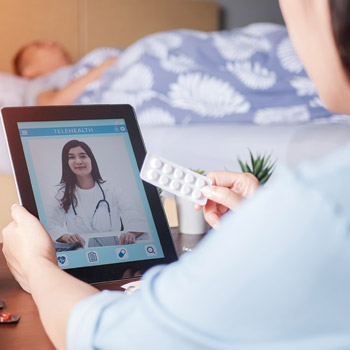Positioning patient portals for success
Recent growth in use of patient portals has been spurred by increases in virtual visits due to COVID-19. But are the systems designed for patients and doctors, or for smoother administrative and billing functions?
There's no doubt patient portals can provide a wealth of information. “From the patient's point of view, portals can do a lot,” said Tom Delbanco, MD, MACP, the John F. Keane & Family Professor of Medicine at Harvard Medical School and Beth Israel Deaconess Medical Center in Boston. “They can tell you what your laboratory results were. They can show you what medications you're on. They can help you ask for refills. Most of them will support secure emails between you and your providers, either directly with your doctors or to your practices. And increasingly, they let you review your clinicians' notes, perhaps the most important part of your medical record.”
But growth in portals in recent years, coupled with increases in virtual visits due to COVID-19, has highlighted both benefits as well as barriers and risks to portal use. A study published Oct. 17, 2017, in the Journal of Medical Internet Research demonstrated that high-speed broadband access at home and self-reported comfort in using the internet were the biggest contributors to whether a patient used a portal.

“On top of that, being [user-]friendly and organized and easy to navigate is really important because the patients who use these systems are not necessarily people that use computers a lot and are very tech savvy,” said Celine Latulipe, PhD, associate professor in the department of computer science at the University of Manitoba in Canada.
A big problem with portals stems from the fact that the target customers for electronic health record vendors have primarily been health systems, then doctors, and lastly patients, according to Dr. Delbanco. These systems are built so hospitals and practices “can maximize their billing abilities properly and so they can have smooth administrative functions,” he said. “But they don't really see through the eyes of the doctors and most don't see very well through the eyes of the patients.”
Physicians' role
Given their greater familiarity with such systems, physicians and their staff may be well positioned to help patients use them. “Physicians should be feeling out the patient to see whether they feel comfortable with technology enough to set up a patient portal,” said Dr. Latulipe.
For starters, patients have to know that they have access to a portal. Physicians should consistently remind patients to set up and use their portal accounts through both oral and written communication, Dr. Delbanco said. “It should be built into clinical practice. That involves the whole staff, the whole team, it doesn't involve just the doctor. It involves the patient. It's really building the patient into the fabric of care much more firmly.”
He advised physicians not to be afraid of patient portals. “Realize that the patient who benefits from the portal will probably benefit you,” he said. “Sit down and work out an educational program for you and your colleagues and also your patients and their families and try to disseminate it to them. Just as we send out notes saying ‘Make sure you get your flu shot,’ we should be sending out notes saying: ‘Make sure you read my note after the visit to remind yourself of what we talked about. Make sure that I didn't make any mistakes in my note that are important and we need to correct. And before I see you next time, I'd like you to send me an update on how you've been doing since our last visit.’”
Physicians may be wary of letting patients see their notes, but such access is required by federal law as of Nov. 2, according to Dr. Delbanco. He is a leader of the OpenNotes movement, which advocates for this type of transparency and studies its effects, and wrote a recent Ideas and Opinions paper on the topic that was published by Annals of Internal Medicine on Oct. 13. As long as physicians write their notes with their expanded audience in mind and without judgment or too big words, he argued, open notes can actually improve care.
“Increasingly, you're writing your notes not only for yourself as reminders, and for your professional colleagues who may also see the patient, but also as a way of communicating with the patients and the families who are reading them,” Dr. Delbanco said. “That's another thing that doctors should realize now.”
Also, while most physicians don't have easy access to change the design of their portals, Dr. Latulipe encouraged them to lobby administrators for system-level changes if additional patient functionality is needed.
Problems with proxy accounts
Other challenges with portals, besides getting patients to use them, include valid concerns about patient privacy and security, particularly regarding caregiver access. In a study published May 4 by JAMA Internal Medicine, Dr. Latulipe and colleagues showed that only 68% of hospitals provided proxy accounts for caregivers to use their portals on patients' behalf.
Optimally, a proxy account would be offered to the caregiver of any patient who expresses hesitation to using his or her own portal—especially due to lack of internet access or limited computer use—and the patient would be able to elect exactly what kind of access the proxy would have, she said. This way the proxy can help with renewing prescriptions, making appointments, and even communicating with the clinic, if that is what the patient needed.
The two-thirds of hospitals with proxy accounts might still have problematic shortcomings, Dr. Latulipe noted. “Even though the proxy account functionality may be there for some patient portals, I don't think the patients necessarily know about it or know that it's there, and it might also be harder, cumbersome, to set up,” she said.
Without a proxy account, patients might be more apt to simply share their portal passwords with caregivers, but that raises privacy concerns, beginning with the amount of information available on the portal, said Dr. Latulipe. Everything from patients' full medical histories to family medical histories, which might include stigmatized illness diagnoses and past reproductive health decisions, is typically available, along with billing and insurance information.
“If you give somebody your password because you want them to help you renew a prescription or look at test results, and they're able to click and see that you owe $170,000 of past medical bills, maybe you didn't want them to know that about you. Or be able to get in and get your insurance information and carry out some insurance fraud,” she said.
Another issue is that since people often recycle passwords, using the same one on multiple sites, a caregiver might be given inadvertent access to a patient's online banking platform, Dr. Latulipe added.
Susan Woods, MD, MPH, senior author of the 2017 Journal of Medical Internet Research study, digital expert, and an internist at Southern Maine Healthcare in Biddeford, said that proxy accounts are “critical,” especially given that not every patient has access to the internet, knows how to use patient portals, or can handle these details when they're sick. “The reality is you need this when you're having the most problems,” she said.
Proxy accounts where the caregiver has his or her own login and password solve the security issue but don't necessarily protect the patient's privacy unless the patient is able to elect exactly what the caregiver can and can't see, Dr. Latulipe explained. “The other aspect to the proxy accounts is if they're really hard to set up, then nobody is going to use them and then they don't solve anything.”
Technological wish list
With the COVID-19 pandemic increasing telemedicine visits, it's likely patient portals are getting more use, although it's too soon to have data on this question, said Dr. Woods. “Some health systems are moving toward a better video telehealth platform, and some of them are going to require patients register and be enrolled in the portal and get into the video visit.”
Because of this, Dr. Woods said she would soon like to see someone design a “portal of portals” to help corral these tools for patients with multiple physicians and specialists. “We need a place for secure authorization where I could then access a variety of health systems' portals,” she said. “It's a nightmare from the patient standpoint. Let's fast forward to each one of those portals having a different telehealth video program, and now I have to go find the portal to get into this video visit and that video visit, so it's kind of a little bit of a maze. I can go to an ATM that's not my bank and they even waive the charges. How easy is that? We need to do the same thing with health care.”
Another technological improvement Dr. Woods would like to see is better mobile applications. “I would like the clinicians to be able to respond securely to messages on a mobile app instead of in their electronic health record,” she said. “The electronic health record is a big, giant time and data suck, and I'd love for both patients and clinicians on the fly to be able to communicate.”
Dr. Latulipe said that portals of the future may involve virtual and augmented reality that could allow simulation of a physical exam. For now, though, she would most like to see proxy support improved with easy access and safety checks.
“If you log in as a patient and your proxy has logged in recently, that should be really evident to you,” she said. “I definitely wouldn't want to discourage caregivers from making use of the patient portals for the person that they're caring for, but we need the functionality to be a little more transparent and easier to set up, and easier to limit access.”





